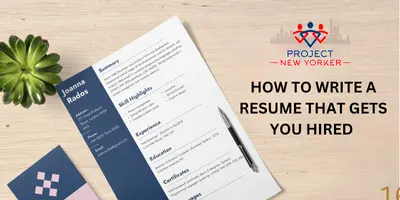How to Write a Resume That Gets You Hired (With Example Templates)

A resume that gets you hired must showcase your skills and experience effectively. It’s more than just a list of jobs.
It’s your personal marketing tool. Crafting the perfect resume is crucial in today’s competitive job market. A well-written resume can open doors and make a lasting impression on potential employers. Think of it as your first chance to shine and stand out among other candidates.
Whether you’re a recent graduate or a seasoned professional, a resume that highlights your strengths and achievements is key. This guide will help you understand what employers look for and how to present your qualifications in the best light. Get ready to learn the secrets of writing a resume that gets you hired!
Key Resume Components
Creating a resume that stands out is crucial to landing your dream job. Knowing the key components of a resume can make all the difference. A well-structured resume should include essential sections that highlight your strengths and qualifications. These sections help employers quickly understand your background and suitability for the role. Let’s explore the key components of a resume that gets you hired.
Contact Information
Providing clear and accurate contact information at the top of your resume is essential. This section should include your full name, phone number, email address, and location. Here’s how to structure it:
- Full Name: Use your legal name, without nicknames.
- Phone Number: Ensure it’s a number you can answer professionally.
- Email Address: Use a professional email address.
- Location: City and state or country, without your full address.
Here is an example of how to format your contact information:
John Doe (123) 456-7890 john.doe@example.com New York, NY
Make sure this section is at the top of your resume. It should be easy to find and read. This helps employers quickly know how to reach you. Keep it simple and professional.
Summary Statement
The summary statement is a brief paragraph that provides an overview of your qualifications and career goals. This section should be tailored to the job you are applying for. It should highlight your key skills and experiences. Here’s how to write an effective summary statement:
- Be Concise: Keep it to 3-4 sentences.
- Tailor to the Job: Include keywords from the job description.
- Highlight Achievements: Mention your top accomplishments.
Example:
Results-driven marketing professional with 5+ years of experience in digital marketing. Proven track record of increasing website traffic by 30% and boosting social media engagement by 50%. Seeking to leverage expertise in content creation and SEO to contribute to ABC Corp's marketing team.
This summary statement is specific and relevant. It shows your value to the potential employer. Be sure to update this section for each job application to match the role.
Work Experience
The work experience section is where you detail your previous jobs and responsibilities. This is often the most critical part of your resume. Employers look for relevant experience and accomplishments. Here’s how to structure this section:
- Job Title: Clearly state your role.
- Company Name: Include the name of the organization.
- Location: City and state or country where you worked.
- Dates of Employment: Month and year of start and end.
- Responsibilities and Achievements: Use bullet points to list key duties and successes.
Example:
Marketing Manager XYZ Corp, New York, NY January 2018 - Present - Led a team of 10 marketing professionals. - Developed and executed marketing campaigns that increased sales by 20%. - Managed a $500,000 annual marketing budget. - Implemented SEO strategies that improved website ranking.
Use action verbs to describe your responsibilities and achievements. Numbers and metrics can help quantify your impact. This makes your experience more compelling. Ensure the most recent job is listed first, followed by previous roles in reverse chronological order.

Credit: www.fiverr.com
Tailoring Your Resume
Writing a resume that gets you hired involves more than just listing your skills and experiences. It’s about presenting your qualifications in a way that aligns with the job you want. This is where tailoring your resume comes into play. By customizing your resume for each job application, you show employers that you are the perfect fit for their team.
Researching Job Descriptions
To tailor your resume effectively, start by researching the job descriptions of the positions you are applying for. Understanding what employers are looking for is crucial.
Break down the job description into key components:
- Responsibilities: Note the main tasks you’ll be expected to perform.
- Required Skills: Identify the skills that are essential for the role.
- Preferred Qualifications: Take note of any additional skills or experiences that are desirable.
For instance, if a job description emphasizes project management skills and experience with specific software, make sure these are highlighted in your resume.
Here’s a simple table to help you organize your findings:
| Job Aspect | Details |
|---|---|
| Responsibilities | Managing projects, leading teams, etc. |
| Required Skills | Project management, software proficiency, etc. |
| Preferred Qualifications | Advanced certifications, specific industry experience, etc. |
By thoroughly understanding the job description, you can tailor your resume to match the employer’s needs.
Customizing Keywords
Customizing keywords in your resume is vital for passing through applicant tracking systems (ATS) and grabbing the attention of hiring managers. These systems scan your resume for specific words and phrases that match the job description.
Here’s how to customize keywords:
- Identify Keywords: Look for repeated words and phrases in the job description. These are likely the keywords the ATS will scan for.
- Integrate Keywords Naturally: Use these keywords in your resume in a way that sounds natural. Avoid keyword stuffing.
- Match Skills and Experience: Ensure the keywords reflect your actual skills and experiences. Authenticity is key.
Consider this example:
If a job description mentions “team leadership” and “budget management” multiple times, make sure these phrases are included in your resume:
- Led a team of 10 in various projects.
- Managed project budgets exceeding $50,000.
Here’s a sample table to track keyword integration:
| Keyword | Included in Resume |
|---|---|
| Team Leadership | Yes |
| Budget Management | Yes |
By researching job descriptions and customizing keywords, your resume will better match what employers are seeking. This increases your chances of getting noticed and hired.
Formatting Tips
Creating a resume that stands out and gets you hired requires more than just listing your skills and experiences. Formatting plays a crucial role in making your resume easy to read and professional. Let’s dive into some essential formatting tips to help you craft a resume that catches the eye of hiring managers.
Choosing The Right Layout
Choosing the right layout sets the foundation for your resume. A good layout ensures your resume is easy to navigate and highlights your most important information. Here are some tips to consider:
- Reverse Chronological Layout: This is the most common layout. It lists your work experience starting with the most recent job. This layout is ideal if you have a solid work history.
- Functional Layout: This format focuses on your skills and experiences rather than your work history. It’s a good choice if you have gaps in your employment or are changing careers.
- Combination Layout: As the name suggests, this layout combines elements of both chronological and functional formats. It highlights your skills and provides a detailed work history.
Here’s a quick comparison table for clarity:
| Layout Type | Best For |
|---|---|
| Reverse Chronological | Solid work history |
| Functional | Career changes, employment gaps |
| Combination | Highlighting skills and work history |
Font And Style Recommendations
Choosing the right font and style is crucial for readability and professionalism. Here are some tips:
- Font: Use a clean, professional font like Arial, Calibri, or Times New Roman. Avoid decorative fonts that might be hard to read.
- Font Size: Use a 10-12 point font for the body of your resume. Your name and section headings can be a bit larger to stand out.
- Consistency: Keep your font style and size consistent throughout the resume. This makes your resume look polished and organized.
- Bold and Italics: Use bold for section headings and italics for job titles or company names. Do not overdo it; keep it simple.
- Margins: Use 1-inch margins on all sides. If you need more space, you can reduce the margins slightly, but keep them no less than 0.5 inches.
Here’s a quick reference:
| Element | Recommendation |
|---|---|
| Font | Arial, Calibri, Times New Roman |
| Font Size | 10-12 point |
| Margins | 1 inch |
Remember, the goal is to create a resume that is easy to read and looks professional. Stick to these guidelines to make a strong impression.

Credit: www.americanrecruiters.com
Highlighting Skills
Writing a resume that gets you hired involves showcasing your skills effectively. Highlighting your skills can make your resume stand out to employers. Skills give a clear picture of what you bring to the table. Let’s explore how to highlight your technical and soft skills.
Technical Skills
Technical skills are specific abilities and knowledge needed for particular tasks. They are often job-specific. Employers look for these skills to ensure you can perform the job duties. Here are some ways to highlight your technical skills on your resume:
- Include a dedicated skills section.
- Use bullet points for clarity.
- List skills relevant to the job you are applying for.
- Use specific software, tools, or programming languages.
For example, if you are applying for a software developer position, your technical skills section might look like this:
| Skill | Proficiency Level |
|---|---|
| JavaScript | Advanced |
| Python | Intermediate |
| SQL | Advanced |
| HTML/CSS | Expert |
Make sure to include only the skills you are truly proficient in. Overstating your abilities can lead to problems later. Highlighting relevant technical skills can significantly improve your chances of getting hired.
Soft Skills
Soft skills are personal attributes that enable you to interact well with others. These skills are not job-specific but are crucial for workplace success. Here are some tips to highlight your soft skills on your resume:
- Mention them in your summary or objective statement.
- Provide examples of how you used these skills in past roles.
- Align your soft skills with the job description.
For instance, if you are applying for a customer service role, you might highlight these soft skills:
- Communication: Clearly conveyed information to customers.
- Problem-solving: Resolved customer issues efficiently.
- Teamwork: Worked well with colleagues to achieve goals.
- Empathy: Understood and addressed customer needs.
Here is an example of how to include soft skills in your resume:
Summary: Dedicated customer service professional with excellent communication and problem-solving skills. Proven track record of working well in a team and empathizing with customer needs.
By showcasing both technical and soft skills, you present a well-rounded image. This can help convince employers that you are the right fit for the job.
Education Section
The education section of your resume is crucial. It showcases your academic background and any relevant coursework. Many employers see education as a key indicator of your skills and knowledge. Highlighting this section properly can make a strong impression.
What To Include
The education section should be clear and concise. Start with your highest degree first. Include the name of the institution, degree obtained, and graduation date. If you are still pursuing a degree, mention your expected graduation date.
Here is how you can structure it:
- Institution Name: Mention the full name of the school or university.
- Degree: Specify the exact degree you obtained, such as Bachelor of Science, Master of Arts, etc.
- Field of Study: Indicate your major or concentration.
- Graduation Date: List the month and year of your graduation.
If you have a high GPA (3.5 or higher), include it. Mention any relevant coursework, honors, or awards. This can show your dedication and expertise in your field.
| Institution | Degree | Field of Study | Graduation Date | GPA |
|---|---|---|---|---|
| University of Example | Bachelor of Science | Computer Science | May 2020 | 3.8 |
| Example Community College | Associate of Arts | Graphic Design | June 2018 | 3.6 |
Highlighting these details can make you stand out. It shows you are serious and well-prepared for the job.
Listing Certifications
Certifications can enhance your education section. They show specialized training and skills. List any relevant certifications you have obtained. This can be particularly important in fields like IT, healthcare, and finance.
Here’s how to list your certifications:
- Certification Name: Include the full name of the certification.
- Issuing Organization: State the name of the organization that issued the certification.
- Date of Certification: Mention when you received the certification.
- Expiration Date: If applicable, include the expiration date.
For example:
- Certified Information Systems Security Professional (CISSP) – International Information System Security Certification Consortium (ISC)², May 2021
- Project Management Professional (PMP) – Project Management Institute (PMI), November 2019
These certifications add value to your resume. They show you have taken extra steps to improve your skills. Employers appreciate candidates who continue to learn and grow. Ensure your certifications are up-to-date and relevant to the job you are applying for.
By including certifications, you demonstrate your commitment and expertise. This can give you an edge over other candidates.
Avoiding Common Mistakes
Creating a resume that gets you hired involves many steps. One of the most important is avoiding common mistakes. Even small errors can make a big difference. They can turn a potential job offer into a rejection. This section will cover some of the most common mistakes to avoid. Pay special attention to spelling and grammar errors, as well as overly complex language.
Spelling And Grammar Errors
Spelling and grammar errors can make you look careless. Employers might think you lack attention to detail. Here are some tips to avoid these mistakes:
- Proofread your resume: Read your resume several times. Look for spelling mistakes and grammar issues.
- Use tools: Tools like Grammarly or Hemingway can help catch errors.
- Ask someone else: Sometimes, it’s hard to see your own mistakes. Ask a friend or family member to read your resume.
Here is a table showing the most common spelling and grammar errors and how to fix them:
| Common Error | Correction |
|---|---|
| There vs. Their vs. They’re | There (place), Their (possessive), They’re (they are) |
| Its vs. It’s | Its (possessive), It’s (it is) |
| Effect vs. Affect | Effect (noun), Affect (verb) |
Remember to take your time. A perfect resume shows you care about the job. It shows you are professional and detail-oriented.
Overly Complex Language
Using complex language can confuse employers. Keep your resume simple and clear. Here are some tips:
- Use simple words: Choose words that are easy to understand.
- Be direct: Get to the point. Avoid long sentences.
- Use bullet points: They make your resume easier to read.
Here is an example of overly complex language and a simpler version:
| Overly Complex | Simpler Version |
|---|---|
| Utilized resources to enhance productivity | Used resources to improve work |
| Facilitated communication between departments | Helped departments talk to each other |
| Implemented strategies to optimize performance | Made plans to do better work |
Keeping your resume simple makes it more effective. Employers can quickly understand your skills and experience. This increases your chances of getting hired.
Effective Action Verbs
Writing a resume that gets you hired involves more than listing your job experiences. One key factor is using effective action verbs. These verbs show your skills and achievements. They make your resume stand out. They give a clear picture of what you have done and what you can do. Choose the right words to leave a lasting impression on employers.
Powerful Descriptions
Using powerful descriptions in your resume is crucial. Action verbs play a significant role in this. They turn simple duties into impressive achievements. For example, instead of saying “responsible for,” use “managed” or “led.” These words show initiative and leadership.
Consider these verbs:
- Managed – Shows leadership and responsibility.
- Implemented – Indicates you introduced something new.
- Created – Shows innovation and creativity.
- Improved – Indicates you made something better.
- Achieved – Highlights your accomplishments.
These verbs create a strong impression. They show you take action and get results. Use a variety of action verbs to keep your resume dynamic. Avoid repeating the same verbs. This keeps your resume engaging.
Here is a comparison:
| Weak Description | Powerful Description |
|---|---|
| Responsible for team projects | Led team projects to successful completion |
| Handled customer complaints | Resolved customer complaints effectively |
| Worked on software updates | Implemented software updates improving system performance |
Use powerful descriptions to demonstrate your value. This approach will make your resume stand out.
Creating Impact
Creating impact with action verbs is essential. These verbs make your achievements clear. They show you are proactive and result-oriented. When you use action verbs, you are not just listing tasks. You are showing results and outcomes.
For instance, consider using words like:
- Generated – Shows you created something valuable.
- Optimized – Indicates you made something as effective as possible.
- Executed – Shows you carried out a plan successfully.
- Designed – Indicates you planned and created something.
- Facilitated – Shows you made a process easier.
These verbs highlight your contributions. They show you make a difference in your role. They give a clear picture of your capabilities.
Here is an example to illustrate:
| Basic Description | Impactful Description |
|---|---|
| Made sales calls | Generated leads through targeted sales calls |
| Helped with marketing | Facilitated marketing campaigns increasing engagement by 20% |
| Fixed technical issues | Resolved technical issues enhancing system reliability |
Choose action verbs that match your achievements. This will help you make a lasting impact. Your resume should reflect your skills and accomplishments clearly and effectively.

Credit: medium.com
Final Review Process
Creating a resume that lands you a job requires precision and attention to detail. The final review process is essential to ensure your resume stands out and is error-free. This stage involves scrutinizing every aspect of your document to make sure it represents you in the best possible light.
Proofreading
Proofreading is a crucial part of the final review process. It helps catch spelling errors, grammatical mistakes, and formatting inconsistencies. Start by reading your resume out loud. This can help you identify awkward phrases and ensure your sentences flow smoothly. It’s also a good idea to use tools like spell check, but don’t rely solely on them.
Here are some tips for effective proofreading:
- Take a break: Step away from your resume for a few hours or even a day. This helps you return with fresh eyes.
- Print it out: Reviewing a printed version can help you spot errors you might miss on a screen.
- Read it backwards: Start from the last sentence and work your way to the top. This forces you to focus on each word.
- Check for consistency: Ensure your formatting is consistent. Check fonts, bullet points, and spacing.
Here’s a checklist to help you during proofreading:
| Checklist Item | Checked |
|---|---|
| Spelling | ✔️ |
| Grammar | ✔️ |
| Consistency | ✔️ |
| Punctuation | ✔️ |
Getting Feedback
Getting feedback from others is another important step. Different perspectives can provide insights you might miss. Share your resume with friends, family, or colleagues. Ask them to review it and provide constructive criticism.
Here are some ways to gather useful feedback:
- Ask specific questions: Instead of a general “What do you think?”, ask targeted questions like “Does this section clearly highlight my skills?”
- Use professional networks: Platforms like LinkedIn have groups where professionals help each other. Join these groups and request feedback.
- Seek help from mentors: If you have a mentor, ask them to review your resume. Their experience can provide valuable insights.
Consider using a feedback form to organize the responses:
| Feedback Aspect | Comments |
|---|---|
| Clarity | |
| Relevance | |
| Formatting | |
| Overall Impression |
Incorporate the feedback you receive and make necessary adjustments. Remember, the goal is to create a resume that effectively showcases your strengths and achievements.
Frequently Asked Questions
What Are The 3 C’s Of A Resume?
The 3 C’s of a resume are clarity, conciseness, and consistency. Ensure your resume is clear, concise, and consistent.
What Are The 5 P’s Of A Resume?
The 5 P’s of a resume are:1. **Presentation**: Ensure a clean, professional layout. 2. **Proofreading**: Check for typos and errors. 3. **Precision**: Be concise and relevant. 4. **Personalization**: Tailor to the specific job. 5. **Professionalism**: Highlight achievements and skills.
What Is The Best Resume Format To Get Hired?
The best resume format to get hired is the reverse-chronological format. It showcases your most recent experience first, making it easy for employers to see your career progression and relevant skills. This format is widely preferred by hiring managers and applicant tracking systems.
How Do You Write A Resume For Winning A Job?
Create a clear, concise resume. Highlight your relevant experience and skills. Use bullet points for readability. Tailor your resume to the job description. Ensure correct grammar and no typos.
Conclusion
Crafting a strong resume can secure your dream job. Highlight your skills clearly. Tailor your resume for each job application. Use action verbs to showcase achievements. Keep the format clean and professional. Proofread to avoid any errors. Follow these tips to impress hiring managers.
Happy job hunting!



